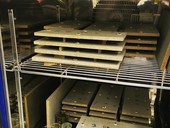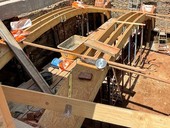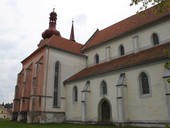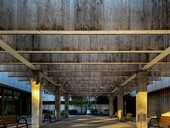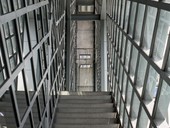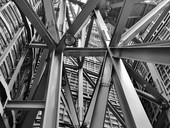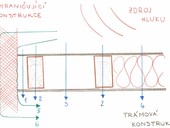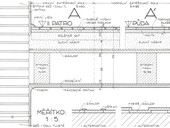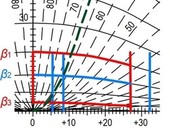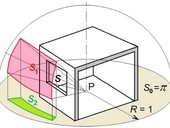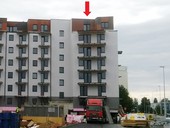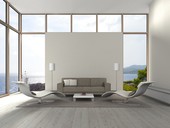In the presented paper, the results of the use of modified gypsum-based recyclate obtained from construction and demolition waste are analyzed. The selected recyclate comes from a real construction site of Moravostav Brno, a.s. and was subjected to modifications using a newly developed gypsum plasterboard recycling line. During the research, the influence of the recyclate treatment, especially in terms of grinding fineness, on the key properties of the dry gypsum mixture was monitored. Substitution of gypsum (or gypsum binder) in the mix was carried out in proportions of 10, 25 and 50 wt%. The resulting properties, such as bulk density, flexural tensile strength, compressive strength, volumetric changes and shrinkage, were monitored after 7 days of sample production.
In a follow-up step, gypsum blocks using treated gypsum recyclate and the designed dry gypsum slurry were semi-produced at Moravostav Brno, a.s. in January 2024. A segment of the wall was constructed from the blocks.
The results obtained clearly show that with appropriate treatment, it is possible to effectively replace part of the gypsum binder in the dry gypsum mixture using modified gypsum recyclate. These findings provide important information for the advanced use of gypsum plasterboard recycling in the construction industry, while highlighting the potential for more sustainable and environmentally friendly practices in building materials.
Archiv článků od 13.11.2023 do 27.5.2024
By digitizing and automating processes throughout the building life cycle, the goal is to optimize the use of information so that it can be easily used either to reduce waste from buildings (waste prevention) or to have sufficient information about the materials and products used in the building at the end of its life cycle or as part of various renovations or retrofits. At the same time, improving the planning and management of the waste generated is a key effort. The paper presents the results of the European RECONMATIC project in this area, which progressively links information efficiency approaches with BIM processes. As such, the project has a broader focus and represents a paradigm shift in the management of C&D materials, from the traditionally conservative approach to C&D waste, to a similarly conservative approach of the construction industry, to construction production that seeks to achieve high waste recovery rates, and to the adoption of a responsive approach to waste recovery. The technologies to be used in this project (creating and working with a digital twin of the building, blockchain-based applications, precision prefabrication, efficient sorting through automation and robotics, etc.) are part of the themes that the project focuses on.
This article deals with the possible combination of high temperature fly ash with fluidized fly ash. The aim of this experiment is to verify the influence of the combination of these two secondary energy products not only on the parameters of cement mortar in its fresh state, but especially on its mechanical parameters in its hardened state.
This paper presents research focused on studying the behaviour and properties of wood-cement composites under changes in relative humidity. The behaviour and the resulting changes in properties with variations in air (relative) humidity are significantly influenced by the chips contained. The chips are mineralised or stabilised during the manufacturing process. The by-product (particle mixture) from the production of cement-bonded particleboards, which was used to modify the composition of the composites, already contained mineralised spruce chips (i.e. stabilised properties and structure). The goal of the research was to study the sorption mechanisms in terms of dimensional and volumetric changes, including the assessment of the composite materials' performance properties (density, strength characteristics and modulus of elasticity). Thus, the influence of spruce chips stabilization in terms of different matrix compositions of the composites was also partially, indirectly analysed. Three variants of composites were tested - 2 types of reference (based on Portland and blended cement); 1 type with modification of the binder and filler with particle mixture produced during the production of cement particleboards (4% cement substitution, 4% substitution of primary chips). For the determination of each point of the sorption curves, the test bodies were always exposed to a given moisture content for a period of time to allow their mass to settle. The sorption isotherms indicate the different behaviour of the plates during the increase and decrease of the ambient air humidity. Differences were also observed in the case of hysteresis. The modification of the composition of the mixture for the production of cement-bonded particleboards has an effect, among other things, on the stabilisation of the spruce chips. The changes in physical and mechanical properties are practically negligible in terms of the practical use of the boards with modified composition.
The paper presents the original condition of the castle in Nemyšl near Tábor together with the subsequent process of its rehabilitation. This requires a careful evaluation of its condition, determination of the remediation procedure along with condition monitoring to ensure safety on the construction site. To accomplish this task - the abbreviation SHM (Structural Health Monitoring) is used abroad - the available possibilities of current information technologies have been used.
The paper deals with the role of engineers in the contemporary world. In particular, it is focused on presenting the current possibilities in preserving historical monuments and their maintenance. In two case studies, point out the new possibilities offered by computer technology and connecting the involved actors through the web. It also mentions the WEC 2023 World Engineering Convention in a certain way. Due to the scale, the first, general part is presented first, which is supplemented by the concept verification while monitoring the retaining wall of St. James Church in Nepomuk. In the following separate paper, an example of the use of these technologies in the rehabilitation of the castle in Nemyšl is presented in more detail.
As a consequence of the growing production and use of asbestos and inorganic fibres, measurement of their concentration in indoor air is of great importance. The relevant legal regulations require the measurement. Various methods were developed for the purpose, based on collecting airborne particles in capillary membrane filters and subsequent determination of their number concentration. Remediation of buildings with fiber-containing construction elements is an essential part of any reconstruction.
This article deals with the possibility of assessing the k-value of power plant fly ash using durability. For cement mortars with replacement of 10, 20 and 30 % of Portland blended cement with fly ash, compressive strengths, efficiency indices, depth of talc water seepage and depth of carbonation were determined for ages of 7, 28, 60 and 90 days. For individual cement substitutes, k-values were determined for a given age using the relationship between water coefficient and compressive strength. According to the results of the hardness tests, the determined k-values were assessed and the k-values that are safe for the use of power plant fly ash in the aggressive environment XC and XD were determined.
This article follows up on Part 1, which dealt with the theoretical knowledge of partial fire protection of steel structures. It focuses on experimental work and numerical models, supplemented by parametric studies. Experiments were conducted on four steel samples, each subjected to a standard fire temperature curve for 60 minutes. The samples were tested with various thicknesses of coatback to determine its impact on the thermal behavior of steel. Numerical models were developed based on the experimental data and used for parametric studies, which examined the impact of various variables, such as the length and thickness of fire protection, on the temperature at the junction of the beam and column. The results show that the thickness and length of fire protection significantly influence the thermal stability of steel structures and can be used to design effective fire protection measures.
This article focuses on the partial fire protection of steel structures and provides a theoretical review of current methods and materials used in this area. Various types of passive fire protection systems are introduced, including intumescent coatings and their influence on heat transfer between protected and unprotected parts of the structure. The article deals with analytical and mathematical methods for determining the thermal properties and fire resistance of the materials used, with an emphasis on those that undergo thermal degradation. This article offers a comprehensive view of the theoretical foundations of partial fire protection of steel structures and proposes directions for further research in this area, providing a basis for Part 2: Experiments, Numerical Models, and Comparisons.
The article is focused on the issue of traditional timber joist floor structures and floor compositions from the period up to the first half of the 20th century. In building practice, we very often encounter these structures in residential buildings that are the subject of structural changes. During these interventions, the basic ideas of the original technical solution are not always respected and some physical parameters of building are degraded. The article describes the principles that were devoted to these types of structures in historical legislative and standard regulations and further in professional literature. The original historical solutions are presented on a practical example. In relation to building interventions in historic timber joist floor structures, current legislative and standard regulations are described, as well as examples of modern solutions and their limitations.
The article is focused on the issue of traditional timber joist floor structures and floor compositions from the period up to the first half of the 20th century. In building practice, we very often encounter these structures in residential buildings that are the subject of structural changes. During these interventions, the basic ideas of the original technical solution are not always respected and some physical parameters of building are degraded. The article describes the principles that were devoted to these types of structures in historical legislative and standard regulations and further in professional literature. The original historical solutions are presented on a practical example. In relation to building interventions in historic timber joist floor structures, current legislative and standard regulations are described, as well as examples of modern solutions and their limitations.
The article deals with the description of selected graphic-numerical methods used to determine the amount of daylight. The principle of derivation of these methods is explained and the principle of working with the relevant diagrams is described. Nowadays, we rarely see the use of diagrams in practice, but some professional software uses them either directly or at least in their graphical outputs.
Starting from January 1, 2023 (in the Czech Republic), on the basis of § 4, paragraph 1 of Decree No. 264/2020 Coll., on the energy efficiency of buildings, it is necessary for buildings or zones with cooling, humidity control or electricity production to calculate the energy efficiency of the building with an interval of one hour. The subject of the article is an approximation of the basic specifics of the hourly step of calculation and a comparison of the results of the calculation and the assessment of energy intensity in the monthly and hourly step of calculation according to the requirements of the applicable legislation.
a. Every leader dreams of a motivated team. In this post, you will learn about the anatomy of success, why some individuals are successful, how success ties into ability, and what it truly means to possess ability, about motivation's various types, how to enhance it and provide support.
b. Každý lídr sní o motivovaném týmu. V tomto příspěvku se dozvíte o anatomii úspěchu, o tom, proč jsou někteří jedinci úspěšní, o tom, jak úspěch souvisí se schopnostmi a co to skutečně znamená mít schopnosti, o různých typech motivace, jak ji zvýšit a poskytnout podporu.
The article deals with the description of selected graphic-numerical methods used to determine the amount of daylight. The principle of derivation of these methods is explained and the principle of working with the relevant diagrams is described. Nowadays, we rarely see the use of diagrams in practice, but some professional software uses them either directly or at least in their graphical outputs.
This article focuses on common issues faced by owners and operators of buildings and technical equipment. Key themes include the lack of proper documentation, failure to meet legislative requirements, and frequent mistakes in safety procedures. The author thoroughly discusses various aspects, including missing documentation, insufficient authorizations and training, and non-compliance with safety standards. The article also emphasizes the importance of proper documentation management and compliance with current legislative requirements to ensure safe and efficient operation.
The paper presents the concept of maintenance engineering as understood in the new European standard EN 17666:2022 Maintenance - Maintenance engineering - Requirements. The standard introduces maintenance engineering as a discipline that uses competencies, methods, techniques and tools to develop and support maintenance to ensure that (maintenance) item is able to perform its required functions in a safe, sustainable and cost-effective manner throughout its life cycle.
The article deals with daylighting assessment in habitable rooms according to the currently valid Czech Standard ČSN 73 0580-2 and according to the Draft Czech Decree on Requirements for Constructions. The case study investigates and compares the daylighting availability in rooms which meet the requirements stated in the draft decree.
zpět na aktuální články



